Chord has been on a roll over the last two years introducing ground breaking digital products. The landscape for digital products has made a significant leap in sound quality over that period of time. The introduction of the Hugo portable amplifier and digital to analogue converter was a game changer. Listening impressions of the Hugo had people ecstatic with the purity and the analogue sound of the music. The Hugo was a groundbreaking design from Chord”s legendary Rob Watts. Rob is the creative genius that keep pushing the boundaries in digital design. The partnership between John Franks and Rob Watts over the years have been creating stellar products that have in my opinion been not only creative, but also groundbreaking and have established new industry benchmarks in digital design.
John Franks is an innovative thinker. He challenged Rob Watts to create a product for the mass market that would be close to the sound of the Hugo but it also had to be more affordable. John and Rob both envisioned the need for a product that could change the sound of portable music devices. The introduction of many portable music players and Iphones and android devices created more listeners with music on the go. The challenge after the Hugo was to create a product that the mainstream could buy, yet still offer sound that would be reference quality. The Mojo priced at $599 was introduced to the mainstream audio world. Once again Chord brought a product that would redefine portable audio. The affordable price was now within the reach of many more listeners and brisk sales have been the norm for the little Mojo. Fast forwarding to 2016 brings us with another top of the line no compromise design from Rob Watts and the Chord team. DAVE has landed and the next chapter begins.
Listening to the DAVE at CES in Las Vegas with the Audeze LCD 4 had my full attention. The DAVE was giving me satisfaction that over the years I had previously struggled to achieve with digital devices. I knew then that I wanted to spend some time with the DAVE in my system and see what Rob Watts’s new design was capable of producing. John Franks and I spoke and he graciously gave us the opportunity to review this world class product.
Design
The DAVE is based on the Spartan 6 field programmable gate array, which was used in the other DAC’s manufactured by Chord. . The main difference is the LX75 is used at the heart of the DAVE. The new design incorporates a huge version of the Spartan 6. The DAVE while using this bigger version of the Spartan 6 delivers music according to Chord with unmatched reality and musicality. DAVE is a preamplifier, headphone amp and world class digital to analogue converter in one well thought out chassis. The specifications are mind-boggling.
Specifications from Chords website:
Inputs:
USB B-style: 44 kHz to 768 kHz – DXD and Quad DSD
2x optical: 44kHz to 192kHz
1 x AES: 44kHz to 192kHz
4 x Coax: 44kHz to 384kHz
Dual-data mode available
Outputs digital:
2x ultra-high-speed coax 768kHz dual-data mode for use with future-unannounced Chord Electronics products.
Maximum output voltage: 6 volts RMS
THD and noise at 2.5 volts: RMS 0.000015 %
THD and noise at 2.5 volts: 127dBA Awt (124dBA into 33 ohms)
Dynamic range at -60 dBFS 1kHz -127 dBA A wt
(No measurable noise floor modulation, no a harmonic distortion)
(Analogue distortion characteristic: no distortion for small signals)
Power requirements: mains power 80 volts to 260 volts; AC 20 watts
The DAVE does uses a USB style input and has a range of 44hz -768HZ and not only does DXD but also Quad DSD. Pricd at $13000 without the optional stand which adds an additional $2500
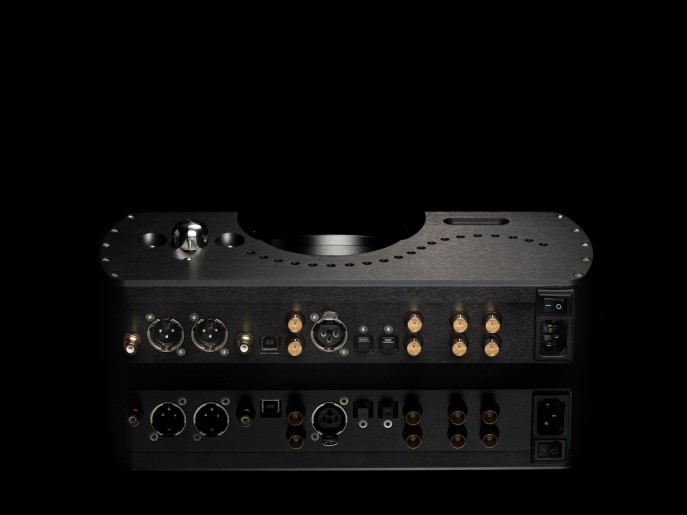
Setup
Lee Shelly took pictures of the DAVE for Chord and delivered it to my house when he completed the work for Chord. Once the DAVE arrived my anxiety levels starting to climb. Remembering those early listening sessions in Las Vegas I was anxious to get it into my system and start listening to music. Using Nordost excellent Heimdall USB cable inserted into the Imac computer provided me with a enormous amount of music to stream through both headphones and also use as full near-field reference system.
The DAVE was also connected to the system with the Rogue Cronus Magnum 11 amplifier and Cavalli Liquid Gold headphone amplifier so it could be used as a DAC in a full stereo system with the Fritz carbon 7 monitors. The cables used were all Nordost Blue Heaven interconnect and speaker cables.
Music sources from the iMac included DSD and high-resolution download files using Aurdirvana and iTunes. Music coming from Tidal’s lossless streaming library gave me an endless CD quality library to listen too. The Dave was ready to be fired up and the anticipation of music coming out of the system put a big smile on my face.
Listening
Once the DAVE was fired up and ready to play music, I put on familiar tracks to get the feel of the music. Primarily using the DAVE with the Audeze LCD4 brought me back to that magical day in January when I fell in love with the DAVE. The sound coming from Holly Cole’s “The Train Song” had me completely consumed with her intoxicating vocals. The sound coming from the system was very transparent and musical. The sound of her voice was alive and more realistic than I have heard it reproduced previously. Listening to headphones is a personal experience and it sounded as if Holly was singing not only to me but for me. The delicate and seductive sound of her voice gave me the chills. Imaging was exceptionally real with Holly in her own space and standing out with each musician also well defined within the sound-stage.
Instruments were also outstanding with the DAVE. The tonality of the bass guitar on Patricia Barber’s Company from “Modern Cool” had the juices going. The LCD 4 reproducing the bass was thunderous and the DAVE was able to reproduce the stellar sound from Michael Arnopols bass with detail and extension. There was no abnormality in the sound. The sound was live and more importantly nailed the tonality of the instrument. The headphone amplifier never called any attention to itself and was always at peak performance. The sound coming from DAVE was beyond anything that I had experienced with any digital converter that has been in the reference system. The DSD recording came to life and it was as if everything just disappeared except the music. There were no boundaries. The system evaporated and music was focused with imaging and sound that was as good as any analogue system I had heard regardless of price.
DAVE was convincing musically. The tonality of the instruments was spectacular. Listening to Bernstein’s Candide with the HiFiman flagship HE 1000 headphones was a revelation. The tonality of the instruments sounded realistic but it also had delicacy reproducing the violins on the Candide Suite. The Reference Recording engineered by Keith Johnson with Eji Que conducting the Minnesota Orchestra put me in the hall. I could hear the room acoustics clearly.
The layering of the orchestra in its proper location and sound staging was wide and deep with air and space between each section of the orchestra. The DAVE just played music. The sound was more like listening to a analogue record without any of the drawback that you would get listening to vinyl and had the explosive dynamics and range that only digital can provide. The DAVE sound was not digital in any way. The musicality and tonality were exceptional.
Argento’s Ring of Time from Valentino Dances also featuring the Minnesota Orchestra is a special piece of music. The chimes in this recording with the right equipment is an incredible listening experience The DAVE nailed the extension of the chimes and you could hear not only inner detail but the hall reverberation in the recording as well. Jaw dropping sound with musicality and tonality that was realistic and alive. The Dave was able to reproduce this track better than I had heard it reproduced in the system, indeed the sound coming from the DAVE had my complete attention and had me in long and deep listening sessions. Amazingly after full days with long hours of listening, it was all without fatigue.
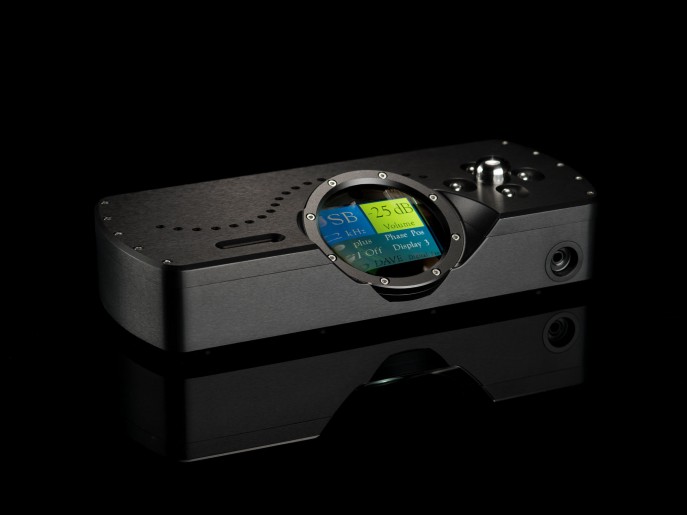
Switching to the Liquid Gold, my reference headphone amplifier and using the DAVE fully balanced, made little difference in the sound. The stand-alone amplifier increased the soundstage minimally. The Liquid Gold can deliver high current with more power but I noticed no difference in musicality or tonality using the Gold over the DAVE’s internal amplifier. The strength of the Liquid Gold is soundstage and bass , and the DAVE as a source was more thunderous and had slightly better staging . I could hear more even more extension and slam but the silky smooth sound of the stand-alone DAVE left little to be desired. The unit was performing flawlessly in the listening sessions and the sound was spectacular.
Intrigued with headphone listening, using the Ether C closed reference headphone from MrSpeakers was a terrific synergistic match for the DAVE. Jeff Buckley’s vocal with his opening whisper on the “Hallelujah” track brought me directly to the recording studio. The delicate sound of his guitar coming from the DAVE and Ether C was a revelation. Buckley’s vocal sounded as if I was in the studio booth with him. I could hear the room acoustics and not get distracted listening to Buckley’s vocal.
This is one of the best renditions of the Leonard Cohen’s tune and has not been surpassed with any performance since Buckley recorded his version . Emotion in the recording was felt with the DAVE and the sound was sublime, yet involving and it sounded spiritual. The delivery and performance had me captivated. I could only hear Buckley’s crystal clear vocal located in a defined space with razor sharp imaging and envision the studio room where he recording this majestic tune. Wow maybe there is a God above lyric started to come to life for me. Listening to Buckley sing it was as if he was empowered from that God above.
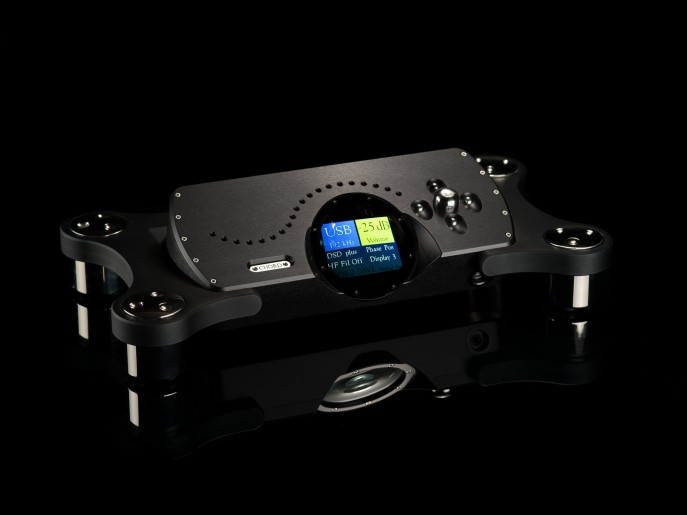
Removing the headphone I switched to the system and replayed the track through the Rogue Cronus Magnum 11 with the Fritz Carbon 7 speakers. Immediately upon playing it on the system, my wife hearing the track left what she was doing and came into the room. She asked what unit was is in the system and thought I playing a vinyl record. I told her it was the DAVE. She told me she never heard the system sound like that before. She sat down and we both started listening together, something we hardly ever do together.
The Rogue Cronus Magnum 11 was synergistic with the DAVE and the Fritz Carbon 7’s. The entire system disappeared and all we were left with was Jeff Buckley in the room. The sound was as if I was playing the best vinyl, but missing was any noise or anything that would distract us from the music we were playing. Buckley’s vocal was a spiritual experience in this system. I could feel as if he connected with me while he was singing this song. Amazingly I was lured into the performance and never wanted it to end.
The DAVE in the 2 channel system continued to excite me with its sound. Using other DACS in the system never had me this excited. Switching to Duke Ellington’s “Back to Back” and listening on the system without headphones had my total attention. Johnny Hodges’s sax on “Wabash Blues” had Johnny coming out of the right channel and the speakers disappeared and the sound was to die for. The musicality and rhythm of the music brought these musicians to my listening room and had Paula and me completely in tune to the performance. She was amazed at how good the music sounded and kept telling me this was the best the system had ever sounded.
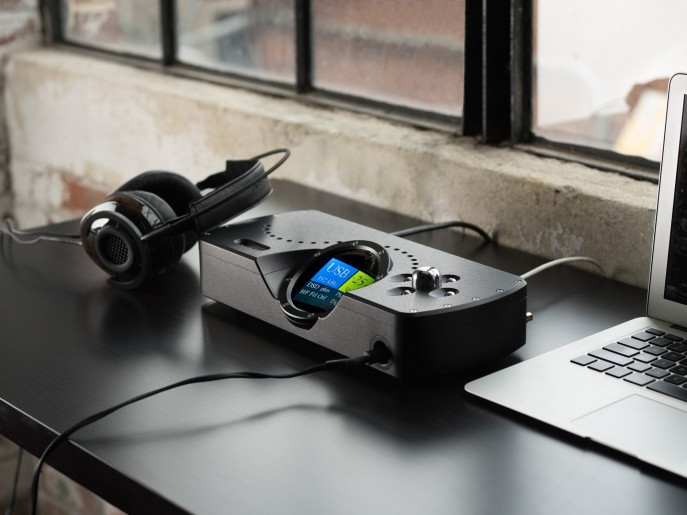
Ellington’s piano came to life and the rhythm section was in tune with the music. It sounded as if they playing in the room. Instruments all sounded as they should and the air and space was beyond reproach. The imaging and detail was all evident on this recording. Air around the performers was among the best I had heard. Hodges sax was floating in its own space and every part of the band had its own defined space and you could hear inner details, like brush strokes on a cymbal clearly. Each instrument solo had its own space with excellent imaging and focus. The DAVE never called attention to any of these recordings that were streaming lossless from Tidal. The performance from Duke Ellington was breathtaking,
Final Thoughts:
When DAVE entered my system I knew that music listening would never be the same once it left. The musicality with the DAVE in the system was the best I have heard from any digital unit has that been in my system. The only digital to analogue converter I have heard that comes close to competing with DAVE is the Spectral 19K SDR-4000 SL, which is also a CD player and converter, minus the preamplifier and headphone amplifier.
The DAVE used as a headphone amplifier competed with my Cavalli Liquid Gold and also functioned as a world class stand alone DAC in the 2 channel system. Listening in my system I was not prepared for how good it would perform as a source and left astonished. Listening with my non-audiophile wife Paula, we both agreed we were hearing the best digital system in my listening room. The sound coming from the DAVE was in another class and at the top of the heap.
Analogue sound has always been a priority in my 2 channel systems. The DAVE made me forget about the analogue and digital debates and stay focused with what is most important to me, which is the music. The DAVE is like adding a fine musical instrument. The $13K price is not inexpensive,but the sound coming from the DAVE is beyond and above anything I have experienced in a high end component. Flawless and near perfect, the DAVE delivers musicality and resolution like no other digital product I have experienced. The sound and tonality of piano and acoustic instrument is beyond realistic –it is real music.
Violins sounds so delicate and yet refined with the DAVE. Body and tonality were what I hear in acoustic halls every time I attend live concerts. Listening with headphones like the LCD-4,Ether C and the HE-1000 made me realize how good the DAVE amplifier was in conveying the musicality I so much crave. Never once did I feel the need to use any other headphone amplifiers other than to make comparisons. The DAVE is a special musical instrument that captured me and had me completely in tune with the music.
If you can afford to write the check or have a system that is looking for the final source to bring all of your music to life,the DAVE can be the answer. For me, sadly I could not figure a way to keep the DAVE. Not that I did not try, especially when Paula (my wife) told me it was the best she heard the system sound. Even after me continuously reminded her of that, I could not convince her to let me write that check. I would have had to streamline my system down and sell of chunks of it to buy the DAVE. If I had the funds to buy the unit I would without question have most definitely written that check.
When DAVE was here, my listening sessions were more involving and musicality soared. Sadly I had to return it and the loss of DAVE has created a void in my listening room(and life). Rob Watts has hit it out of the park with this design and John Franks the innovator and master behind the scenes at Chord keep raising the bar and Rob Watts always delivers and exceeds the goals he sets for himself. Chords team is gifted and talented and continues to keep changing the benchmark of what products should be. DAVE I will miss you and look forward to our next encounter. Highly recommended www.chordelectronics.co.uk/Photography by:leeshellyphoto.com/














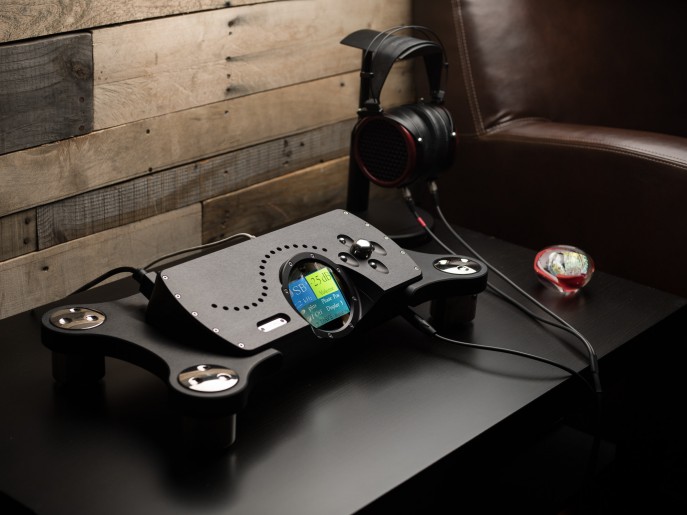
Reply
Reply
Reply
Reply
Reply
Reply
Reply
Reply
Reply
Reply
Reply
Reply
Reply
Reply
Want to join discussion?
Feel free to contribute!